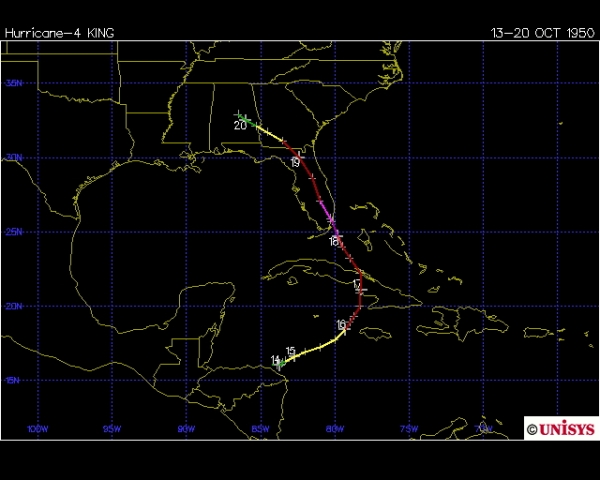
In the early morning hours of October 18, 1950, violent Hurricane King struck Miami, FL bringing wide-spread destruction to south Florida. It was the most devastating tropical cyclone to hit the area since the Great Miami hurricane of 1926.
The storm had its origin on Oct. 13th, in the climatologically favored region for mid-October, the western Caribbean Sea. It idled off the coast of Honduras for a day before moving off to the northeast. It became more organized as it moved away from land and reached hurricane status as it moved west of Jamaica. Earlier in the 1950 hurricane season, the Miami Hurricane Warning Center had begun to use the Air Force’s custom of designating tropical storms using the Army/Navy Phonetic Alphabet. As the eleventh storm of the season it was assigned the name “King”.
After passing Jamaica, King began to curve northward and intensify. By the time it made landfall near Camaguey, Cuba, its maximum sustained winds were near 90 mph (150 km/hr). It crossed over the island in six hours, losing some strength as it did so. However, once it moved back over the ocean, it began to rapidly restrengthen and move on a north-northwesterly course toward Florida. Warnings were posted for south Florida to expect a major hurricane within 18 hours. As it approached the state, the hurricane was under surveillance by Hurricane Hunter aircraft, which documented a deepening of the central pressure by 33 mb and a contraction of the eye from 20 miles (32 km) down to 5 miles (8 km) in diameter.

The eye came ashore in southern Miami with the eastern eyewall passing over Key Biscayne, Virginia Key, and Miami Beach. The western eyewall passed over Coral Gables and Miami airport. The Miami Weather Bureau office recorded a maximum sustained wind of 122 mph (197 km/hr) during its passage. King was a very compact hurricane, and its damage swath was sharply delineated. Grady Norton, chief of the Miami Hurricane Warning Center, likened this destruction to a large tornado. King then accelerated up the peninsula of Florida as it unraveled and lost strength. It was still a hurricane as it passed by Tallahassee, but became a tropical storm over Georgia and eventually dissipated as a depression over Alabama. While King only caused 11 direct deaths, it was responsible for some US$32 million in damages.